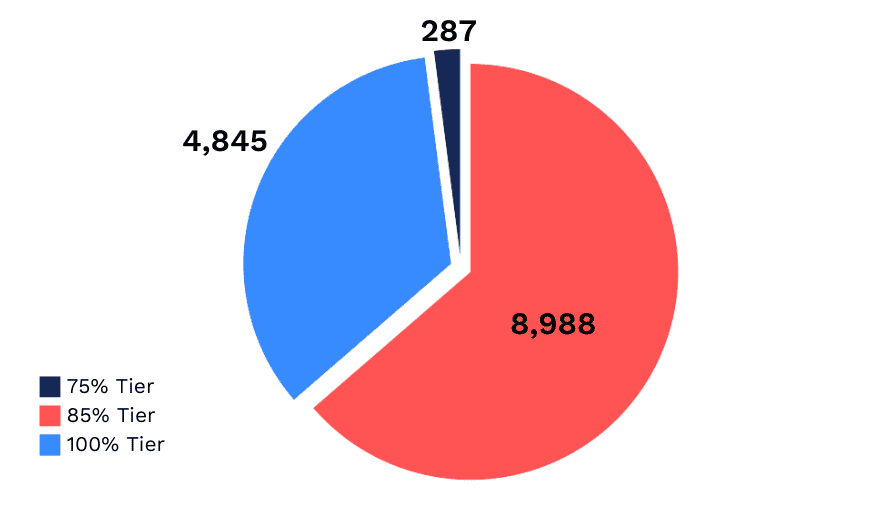What is “truth-in-sentencing”?
Before 1998, people incarcerated in Illinois prisons could proactively earn time off their court-appointed sentence through good behavior and participation in prison programming. Overall, these credits could reduce a person’s sentence by up to half, or a day off for every day in prison.
This system changed in 1998 with the passage of the so-called “truth-in-sentencing” (TIS) laws. Today, these laws limit the amount of time people convicted of certain offenses can earn off their non-life sentences.
People who are incarcerated may be broken into five “tiers” based on how these sentencing laws affect them, as follows:
- Day-for-day: people who are incarcerated may earn up to one day off their sentence for each day served (i.e., 50%)
- 60%: people who are incarcerated must serve a minimum of 60% of their court-appointed sentence.
- 75%: people who are incarcerated must serve a minimum of 75% of their court-appointed sentence.
- 85%: people who are incarcerated must serve a minimum of 85% of their court-appointed sentence.
- 100%: people who are incarcerated must serve their full sentence (100%) and are ineligible for any amount of time off due to good behavior or programming.
Originally, there were only 85% and 100% tiers for TIS. The 75% tier was created in 2007 for Class X felony offenses for delivery of more than 100 grams of a controlled substance. The 60% tier was created through a bill passed in 2017 that permits people convicted of all offenses in the 75% tier (except gunrunning) to now earn through earned discretionary sentence credit and earned program/education credits up to 40% time off sentence, creating a new 60% tier.
As of December 2024, almost half (49%) of the people incarcerated in Illinois were serving sentences affected by TIS laws. Figure 1 shows the distribution of these people into different tiers.
Figure 1. People serving TIS-impacted sentences by tier

Caption. Data were sourced from IDOC’s public report on prison population as of December 31, 2024.
Most people in the 75% tier are serving sentences for drug-related offenses, while the 100% tier is composed almost exclusively of people convicted of first-degree murder. The 85% tier is the largest by population and includes a broad range of convicting offenses. The median sentence for people in the 85% tier is 12 years. Nearly 1 in 3 people in the 85% tier are serving 20 years to life.
Why does it matter?
The idea that people who are incarcerated are able to earn time off their sentences might be surprising to some. After all, why shouldn’t judges have the final say in how long a person serves? It was largely this idea—combined with the sense that the criminal legal system ought to impose stricter penalties on more serious crimes—that led legislators to pass TIS.
The Violent Crime Control and Law Enforcement Act of 1994, commonly known as the 1994 Crime Bill, incentivized states to adopt more punitive sentencing policies through federal grant funding. This program provided federal funding for the construction and expansion of state prisons to states that implemented TIS laws. Illinois responded to this financial incentive, receiving a total of $124 million in grants between 1996 and 2001 to build more prisons.
When policymakers first introduced TIS in Illinois, many claimed it wouldn’t meaningfully lengthen prison stays. State legislators expected judges would issue shorter sentences to account for the fact that people would serve a greater proportion of their time behind bars. But that didn’t happen. Judges generally did not adjust sentence lengths to account for reduced sentence credits. As a result, people convicted of offenses subject to TIS laws serve significantly longer in prison—sometimes twice as long as they would have under the previous system.
But limiting the ability to earn time off sentence runs against the rehabilitative mission of correctional systems. TIS is also unnecessary to preserve the power of judicial discretion
Most people who enter prison will one day return to society. Therefore, restricting the ability to earn time off their sentences through positive behavior and programs only teaches these people—especially those who enter as children or young adults—that the system believes them to be beyond reform.
“Truth-in-sentencing” only teaches people—especially those who enter as children or young adults—that the system believes them to be beyond reform.
The argument that TIS protects final sentences of judges from “circumvention” by sentence credits is also misguided. While it is true that numerous laws have reduced judicial discretion over the years, these changes—from automatic transfer laws to mandatory firearm enhancements—primarily work to prevent judges from imposing more forgiving sentences, not from dispensing harsher ones.
For instance, a first-degree murder conviction carries a sentence of a minimum of twenty years to a maximum of sixty years or life (before firearm enhancements). With such a broad range, judges who believed a longer sentence was justified could choose a sentence length toward the higher end of the range. TIS hardly seems necessary to ensure individuals serve longer behind bars.
Want to learn more?
One of the most troubling aspects of TIS is how it interacts with other “tough-on-crime” policies. Consider, for instance, how TIS combines with mandatory firearm enhancements and laws that allow automatic transfer of juveniles to adult court.
Individually, each law punishes people who are convicted of committing crimes with firearms. TIS restricts good time, while a firearm enhancement increases time served. On top of this, automatic transfer makes even children eligible for these harsher punishments (and don’t forget, Illinois doesn’t have parole for most people).
That means that until a few years ago, a judge would have no choice but to sentence a 17-year-old who was convicted of stealing $250 in an armed robbery during which they fired a bullet into the ground to a minimum of 26 years, of which at least 22 must be served. Specifically, after being automatically transferred to adult court due to the nature of the crime, the 17-year-old defendant would face a minimum of 6 years for armed robbery, plus a mandatory 20 years added for the firearm enhancement. The entirety of this 26-year sentence would be subject to TIS.
In 2016, the Illinois State Commission on Criminal Justice and Sentencing Reform—a bipartisan commission established by Governor Bruce Rauner to develop strategies to reduce the prison population in Illinois—called out TIS as one area in need of reform. You can read more about why the Commission called for a rollback of TIS in their final report (see recommendations #18 and #19).
Unfortunately, neither of these recommendations were realized to any substantial degree.
Linked Sources
Heaton, R. et al. (2016, December). Final report of the Illinois State Commission on Criminal Justice and Sentencing Reform. Chicago, IL. Retrieved from http://www.icjia.state.il.us.
Olson, D., Griffin, P., Einstein, L., Halladay-Glynn, M., & Lira, B. (2025). Truth in sentencing in Illinois prisons. Loyola University Chicago Center for Criminal Justice. https://loyolaccj.org/blog/truth-and-sentencing-in-illinois-prisons
United States General Accounting Office. (1998). Truth in sentencing: Availability of federal grants influenced laws in some states. https://www.govinfo.gov/content/pkg/GAOREPORTS-GGD-98-42/pdf/GAOREPORTS-GGD-98-42.pdf
U.S. Department of Justice. Violent offender incarceration and truth-in-sentencing incentive formula grant program. Bureau of Justice Assistance. https://bja.ojp.gov/sites/g/files/xyckuh186/files/media/document/voitis-final-report.pdf

